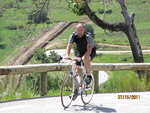Thanks for the replies Timpo, JRA and Alex M
Right now Trek seems to have the leg up on everyone else, mainly because they've already been in the police bike business longer than anyone else (who's still standing). That's impressive when you consider that police bike sales are minuscule. However, bike manufacturers realize that tacit product validation is a very real thing. Quite literally, sales in the Dayton area of the particular brand of bikes we were using at the time were always better. We changed brands, sales shifted and not just on mountain bikes. That said, those sales were in the "bread and butter" sector and not high end sales (for a brand bike shop). The higher end customers had their own and probably correct, ideas of what they needed as opposed to relying on "If it's good enough for the Dayton Police, it has to be good enough for me".
What I know now that I didn't know before. Mid-drives seem to handle the best for our purposes, both in power application and weight balance. Police/EMS/Public Safety bikes are already rear end heavy, especially EMS. Hub drive set ups make rear wheel bias and damage more pronounced. In addition, the hub drive can't take advantage of the bike's gearing to conserve power. Flat tire repair is easier with a mid drive as well. There seems to be another difference (at least to me) between hub drive and mid-drive; hub drives seem to "push" the bike and mid drives seem to "propel" the bike as one would with the pedals. That might not make sense and it could be my imagination as well. At the very least, a police E-bike needs a walk button so the bike can be propelled up steps or over obstacles too large to ride over; say for instance pushing the bike up several flights of steps. A throttle is nice as well but not mandatory in my book.
The price of the bikes are up there compared to a completely pedal operated bike, BUT, there are real life cost considerations that can make the 5K per unit a bargain. In the case of rapid response to a citizen injury, house fire, etc the E-bike offers the responder the opportunity to arrive with all their anaerobic strength and in the best possible position to help successfully, regardless of responder age or fitness level. Saving a life is ALWAYS worth the money. The other area of E-bike "cost effectiveness" is suspect contact and apprehension. Having all (or mostly all) of one's physical abilities when the chase draws to a close and you go hands on can save a violent suspect's life in that an officer who is still fresh can more likely overcome the suspect in lieu of having to rely on deadly force to save their own life because of strength differentials. Despite what many people think, having to take a life is the 2nd to last thing you want to happen; the last thing is being killed and not being able to perform your protective duties. When you pinned on that badge, you gave up your right to give up. Add to all that, just one "wrongful death" suit settlement can buy a lot of E-bikes, even if the officer was completely justified.
We have many areas in Dayton that have been blocked off with brick and steel gates that allow limited car access to reduce crime. In these neighborhoods, bikes can beat cars to the scene easily. Responding officers who are also on E-bikes can assist much faster than officers in cars and be relatively just as fresh. The big thing about cost isn't what administrators consider to be excessive spending, it's what the tax payers believe is excessive or wasteful. When it comes to the cost of anything in police work, the tax payer drives the buggy, as they should.
I said all that to say this, yes E-bikes can be expensive, but sometimes the cost of NOT having something can be much higher.







